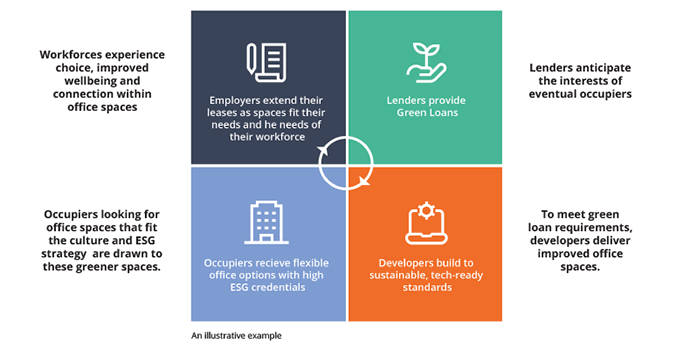One Size Fits None

Return to office? It’s not a simple fix
Return to office? It’s not a simple fix
Following the impacts of the pandemic, companies are trying to adapt to the global shift in working patterns – which includes the ever-evolving expectations of their workforce. In the same breath, companies are also attempting to drive business growth through economic and ESG considerations. The workplace’s role in delivering against both these points is crucial – and the direction of the flex market will be a key indicator of trends.
Focusing on the shift in working patterns, there is no obvious silver bullet solution to help companies determine the best solution for their employees. End users of office space want choice and experience. The post-pandemic mindset has shifted from the general acceptance of a Monday to Friday (9-5) working culture to a desire for more flexibility. Most business leaders would agree that things have changed for good – and they want (and need!) to be able to offer their staff an improved working environment and experience. However, these new elements of workplace experience will differ on a company-by-company basis.
On a basic operating level, no two businesses are the same. Additionally, each business’s real estate position – i.e., office leases or licence agreements - is unique. It is increasingly apparent that the ‘one size fits all’ traditional approach to office leasing is no longer the most successful model. Instead, flex offerings allow companies to adapt to the needs and demands of their workforce, whilst also being commercially and socially conscious.
The design-centred evolution of flex
The global occupier market is responding to change and companies are searching for office space that meets both the personal and professional needs of their diverse workforces. In parallel, the global investor market is attempting to meet the evolving needs of the occupier market.
The traditional lease mechanism affords a high degree of control to the occupier in terms of floor design and experience. Occupiers want to create a space and environment that is complementary to both their business’ branding strategy and culture. The concern in current market conditions is that creating such a space can be expensive, and there is no guarantee that the design itself will be functional for the length of the lease.
The growth in flexible office operators is the most obvious indicator of change. Originally seen as disruptors to the traditional office market, the flex model has now become crucially intertwined with investor and occupier markets.
The evolution of office design and the wider office “experience” is something several landlords and flex operators have embraced and delivered exceptionally. One argument to make in this regard is that certain flex operators who were “design-led”, with end user experience at the fore, achieved the greatest level of occupier demand.
Flex operators helped create a shift in user expectations and this ultimately forced landlords and investors to sit up and take note. As a result, we have the much more generally accepted view that the end user needs to be front and centre of office design considerations. However, there is still a portion of the global office market lacking consideration of the end user experience before committing to a redesign or asset repositioning.
The occupier as a key stakeholder
The ability for the world’s largest companies to create headquarters and campus style environments for their staff, packed with amenity and enhanced experiences ought to be replicated across the entire office market. The experience of a one-person start-up within single floor office should be able to match that of an employee at a global tech firm. The market leading flex operators deliver this with impressive ease and consistency. The ability to create an enhanced user experience is evolving at an exciting rate.
The flex model offers the ability to book an area to work, meet or connect in advance of arrival. This is combined with the option of wellness facilities in dedicated studios, all centred around a building design that has high ESG credentials. The best-in-class flex operators allow the single user an experience that would only have been historically available to staff working at a small % of top firms.
Landlords and investors want to understand the end user’s needs and are therefore placing new importance on occupiers as stakeholders. We are seeing a growing emergence of design conscious landlords. They want to design and deliver office space that meets the needs of the end user. As a result, landlords are seeing a greater degree of letting success, with improved rental profiles. More importantly, landlords are working with businesses to offer a solution to allow them to adopt to the changing working patterns at a scale that works for them.
Green Investment
However, the next fundamental change in the office market will be driven by the proverbial top of the ‘office food chain’ – the lenders. Today’s prevailing economic climate sees investors tightening purse strings and focusing on assets that provide consistent, guaranteed ROI. These lenders could view flex assets as carriers of additional risk, due to shorter leasing agreements and tenant turnover – key outcomes of the inherent flexibility that is offered to occupiers.

For flex models to succeed, lenders will need to start focusing on green investment. Traditional debt financing will need to be replaced by green loan-style agreements that are contingent on the provision of ESG deliverables including – but not limited to - carbon neutrality, improved energy efficiency, wastewater management, and social value delivery. If lenders tie debt finance to these deliverables, they are anticipating the eventual needs and demands of potential occupiers and their workforces. Forecasting this demand and designing flex spaces that align with these demands will promote increased engagement from occupiers and perhaps longer leases. The ability for landlords to pass these ESG commitments onto occupiers and businesses is also vitally important and ultimately it is the end user who will benefit – and should benefit – from this. Finally, as lease lengths increase, these greener flex office spaces will experience decreased risk and provide comparable security to traditional office assets.
At the end of the day, the role of businesses in society cannot be overlooked, particularly in a world where some see the relationship between employer and employee becoming more “remote”. The wider economic, social, and environmental impact business has on our world needs to be acknowledged - and in a positive manner. There is no doubt that the built environment has a major role to play in how we address global challenges including the global warming crisis and social inequality.

Martin Devine is a Principal for Flexible Office Advisory and Transactions, UK and Ireland
